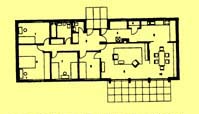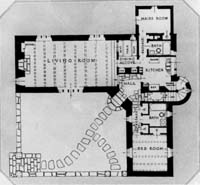



Many small households, not large enough to have a full fledged nursery, not rich enough to have a nanny, find themselves swamped by the children. The children naturally want to be where the adults are; their parents don't have the heart, or the energy, to keep them out of special areas; so finally the whole house has the character of a children's room - children's clothes, drawings, boots and shoes, tricycles, toy trucks, and disarray.
Yet, obviously few parents feel happy to give up the calm and cleanliness and quiet of the adult world in every square inch of their homes. To help achieve a balance, a house for a small family needs three distinct areas: a couple's realm, reserved for the adults; a children's realm, where children's needs hold sway; and a common area, between the two, connected to them both.
The couple's realm should be more than a room, although rooms are a part of it. It is territory which sustains them as two adults, a couple - not father and mother. Other parts of their lives are involved with children, friends, work; there must be a place which becomes naturally an expression of them as adults, alone. The children come in and out of this territory, but when they are there, they are clearly in the, adults' world. See COUPLE'S REALM (136).
The children's world must also be looked upon as territory that they share, as children, CHILDREN'S REALM (137); here, it is important to establish that this is a part of the house, in balance with the others. Again, the critical feature is not that adults are "excluded" but that, when they are in this world, they are in children's territory.
The common area contains those functions that the children and the adults share: eating together, sitting together, games, perhaps bathing, gardening - again, whatever captures their needs for shared territory. Quite likely, the common territory will be larger than the two other parts of the house.
Finally, realize that this pattern is different from the way most small family homes are made today. For example, a popular current conception, comparable to this, but quite different, is a suburban two part house: sleeping and commons.

Even though there is a "master bedroom" the sleeping part of the house is essentially one thing - the children are all around the master bedroom. This plan does not have the distinctions we are arguing for.
Here is a beautiful plan which does:


